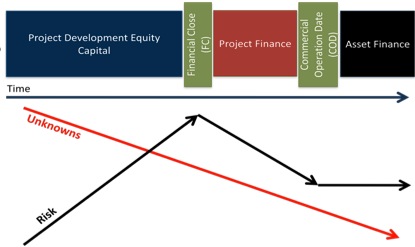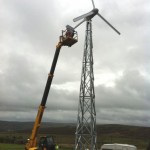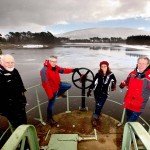Do you want to erect a wind turbine? Cover a storehouse roof with photovoltaic modules? Or perhaps you want to get the old village waterwheel turning again and generating electricity. What do you need to consider? Where do you start on a project like that?
The National Renewable Energy Laboratory has published “A Framework for Project Development in the Renewable Energy Sector” that includes a 10-step framework for project-managing from renewable energy concept, through project development, project finance and construction, to commercial operation.

Risk rises with early expenditure, even through the number of unknown issues reduces (Image from NREL report)
BEPTC
The report sets out five building blocks for a well-motivated project (summed up in the less-than-catchy acronym BEPTC)
Baseline
The fundamental reason why the project is necessary or desired – ideally in one or two sentences.
For instance, it might be:
“We can no longer depend on our inefficient and expensive diesel generator.” Or, “A working waterwheel as an attraction on the side of the millhouse café would dramatically increase revenues while reducing energy bills.”
Economics
You should undertake an objective analysis of the total cost of acquiring energy from existing sources and compare that to the cost of energy from the proposed new renewable energy source. Any negative economic differences, even those that only occur in the early phases of operation, need to be acknowledged and dealt with upfront.
As a rule of thumb, says NREL, if a project does not generate a margin of 20% – 30% above its cost estimates, it may not be worth the effort. If that is the case, you will need to find a way to improve the situation.
Policy
Government and local regulatory policies must be examined to see if they create barriers. If there are policy challenges, you need strategies to overcome them.
Technology
Assessing the commercial technologies available, establishing their reliability and ‘bankability’ (willingness of bankers to stump up the money for the technology), will probably be the easiest part of the whole process, says Springer.
Consensus
The first four steps establish a clear understanding of the project aims. Through good communications and consensus-building, that can convert to a common understanding and support from the project across everynone involved. Without consensus, stakeholders can become adversaries before the project has even begun.
Fatal Flaw Analysis
Now that the project is clearly defined and everybody is on board, you need to take a look at what you know and combine it with your assumptions to identify areas of risk to project completion.
SROPTTC
There are seven key areas that you must look at: Site, Resource, Off-take, Permits, Technology, Team and Capital. (Stringer has combined them in the acronym: SROPTTC.)
Site
Besides the site’s technical and physical restrictions, you need to be clear on your property rights – from the exact boundaries to your length of tenure and your ability to assign those property rights to others. You should also consider conflicting or competitive uses for the land that may affect the project.
Resource
Eventually, the renewable resource will need to be understood in great detail and with great certainty. But at the early feasibility stage a general assessment of availability may be enough.
Off-take
Buyers for the energy, but also buyers for any renewable energy credits, must be established and secured by contract. Your ability to establish interconnections and to transmit your energy to market must also be established. You will need a clear financing route map with confirmations of the relationships. When all these issues are combined, Springer calls them ‘off-take’.
Once your Site, Resource and Off-take issues have been ascertained, the core of your project development has been achieved.
Permits
Investment in planning, environmental and operational approvals and licences usually follows once issues around the site, resource and off-take elements have been resolved.
Technology
Next, you need to get into the detailed investment, engineering design, equipment selection and procurement questions.
Team
When you are assembling your project team, you need to think about things other than your personal work style and relations. If you hope to raise finance, the investors are going to study your team carefully to ensure they have the qualifications and track record to deliver this project.
Capital
If you have addressed the project motivation, site, resource, off-take, permitting, technology and team issues successfully, you are in a position to attract the financial resources you will need to move to completion.
Incremental is best
People often assume that a project’s risks are greatest at the very start when the participants have least knowledge. That is not actually true. At the start of a project, there has been little investment of time or resource, so there is little to risk. The risk rises during the development stage as early project investments are made at a time when levels of uncertainty are high. The risk is often at its height close to financial closure. By the time construction starts, most of the unknowns should have been identified.
But at all stages through to commercial operation, there are risks involved in renewable energy development projects. It makes sense to take an incremental approach to investment with a regular loop-back procedure where you ask yourself the fundamental questions once more. Can this project succeed or are we glossing over some fatal flaw?







No comments yet.